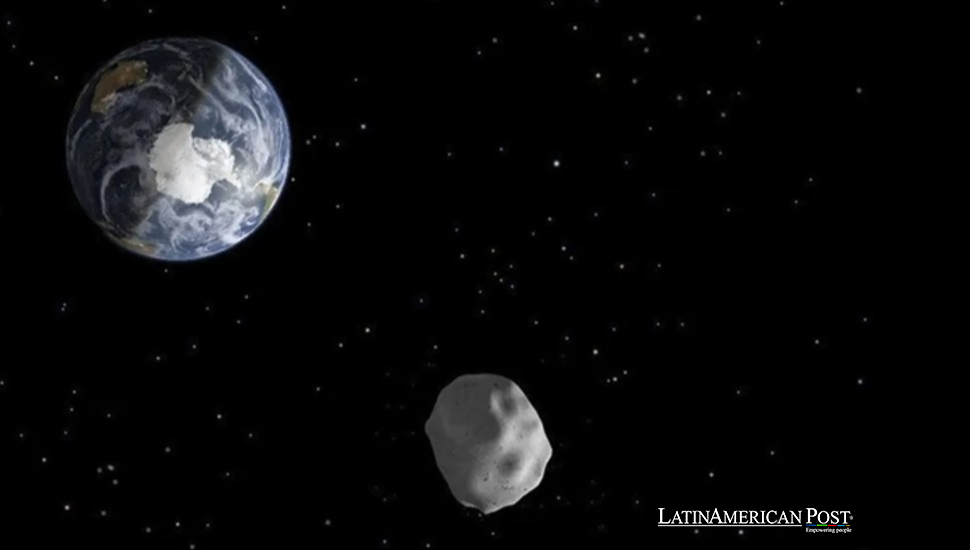Colombia, Ecuador, and Venezuela Among High Risk Countries of Potentially Catastrophic 2024 YR4 Asteroid Impact

The recent discovery of a potentially catastrophic asteroid, 2024 YR4, has sparked widespread concern in Latin America. With Colombia, Ecuador, and Venezuela directly in its path, urgent questions about the risk of impact, emergency planning, and the necessary scientific advancements to avert this cosmic threat are mounting.
The Asteroid’s Path and its Latin American Focus
On December 27, 2024, the Chilean station of the Asteroid Terrestrial-Impact Last Alert System (ATLAS) detected a worrisome space rock dubbed 2024 YR4. This early detection signaled that the object was cruising through the solar system with an orbit of about 3.99 years. Merely two days before its discovery, on Christmas Day, it had approached Earth at a distance of 515,000 miles—more than twice the gap from Earth to the Moon, but still uncomfortably close by astronomical standards.
Reports show that as of January 31, 2025, the asteroid sits some 30 million miles away. By April of that year, Earth-based telescopes will lose track of it. Astronomers anticipate reacquiring it in June 2028, yet a truly precise size measurement may remain elusive until at least 2032. Based on limited data, scientists believe 2024 YR4 could measure anywhere from 130 to 300 feet (about 40–90 meters) in diameter. This wide-size estimate leaves open a vast range of impact scenarios.
While an asteroid this big might not be world-ending, it could nevertheless inflict severe damage if it collides with our planet. Experts forecast that if 2024 YR4 struck Earth, it could produce explosive energy of up to 8 megatons of TNT—roughly 500. It was many times as strong as the Hiroshima bomb. At present, astronomers assign a 2.3% probability of an Earth impact on December 22, 2032. Although that might sound small, even a percentage above 1% causes alarm in the scientific community. In part because of its predicted travel corridor near the equator, the countries most in jeopardy are Colombia, Ecuador, Venezuela, and several others spanning from South Asia to Eastern Africa.
For Latin America, this predicted corridor underscores the looming threat. Cities in Colombia, Ecuador, and Venezuela can’t afford complacency. If 2024 YR4 slams into a populated region, the loss of life and destruction could be profound—particularly in dense urban centers. The scenario is reminiscent of the asteroid that burst over Siberia in 1908, flattening roughly 770 square miles of forest. A city-size blast in Latin America would undoubtedly prompt a humanitarian crisis. The stakes, therefore, are high, and these nations are watching developments closely.
Concerns Over Size and Potential Consequences
Scientists determine an asteroid’s diameter partly by measuring how much light it reflects, which can be misleading if the object is either especially shiny or extremely dark. Radar-based measurements yield more reliable numbers, but 2024 YR4 won’t pass close enough for accurate radar analysis until much later in the decade. Even then, the pass in December 2028 remains at a distance of 4.7 million miles—too far for a conclusive reading.
Due to the uncertainty surrounding the asteroid’s size, the exact threat it poses remains unclear. A 130-foot-diameter asteroid could cause a Tunguska-like event, similar to the one that occurred in Siberia in 1908. However, a 300-foot-diameter asteroid could be significantly more destructive. In terms of volume, a 300-foot-wide asteroid has about 11 times the volume of a 130-foot-wide asteroid, potentially escalating the impact from a ‘city destroyer’ to a ‘major regional catastrophe ‘.
If 2024 YR4 hits land—especially in a densely populated region of Colombia, Ecuador, or Venezuela—the immediate blast radius might extend roughly 30 miles. Nearby areas could suffer devastating shockwaves, intense heat, and fires. If it hits the ocean, the tsunami may flood coastal cities and force many people out of their homes. Whatever the situation, the results will challenge these nations’ infrastructure and emergency services. Ecuador and Colombia have mountains; Venezuela has large rivers. Local regions differ significantly. Some topographies might shield communities from shockwaves but also concentrate the force of landslides or tsunami-like flooding if the impact prompts enough seismic energy.
For now, astronomers place 2024 YR4 at a Level 3 on the Torino Impact Hazard Scale, which ranges from 0 to 10. Although 3 might not appear alarming, it remains higher than any other known asteroid at present. Once experts refine the object’s trajectory and size, the rating could shift—potentially down if new data reveals it to be smaller or on a path that misses Earth. That said, the margin for error is still substantial. If the asteroid leans toward the bigger end of current estimates, the threat level might climb further.
Current Strategies and Regional Preparedness
In 2022, NASA showcased an early planetary defense triumph: ramming a spacecraft into a distant asteroid to test whether its orbit could be altered. Dubbed the Double Asteroid Redirection Test (DART), the project confirmed that kinetic impactors can indeed divert space rocks. This success fuels hopes that if 2024 YR4 proves truly dangerous, an internationally coordinated mission might steer it away in time. This potential for global cooperation in the face of a common threat is a source of hope. However, such an endeavor demands global cooperation and must be executed well in advance, and last-minute heroics might not be feasible.
Latin American countries, especially those close to the equator, have reasons to strengthen their readiness. Colombia, Ecuador, and Venezuela have distinct vulnerabilities—particularly in their large urban centers like Bogotá, Quito, Guayaquil, and Caracas. Urban sprawl, limited emergency infrastructures, and the risk of significant population displacement in a disaster highlight their needs:
Enhanced Tracking Efforts: While NASA and ESA (European Space Agency) lead the majority of asteroid tracking, Latin American telescopes, like those in Chile, also prove essential. More regional observatories or partnerships might enable earlier detection of near-Earth objects.
Public Awareness Campaigns: Governments in Colombia, Ecuador, and Venezuela could educate citizens on basic steps for emergency readiness. Emphasizing that the current 2.3% impact chance is still relatively small might stave off panic, yet officials should prepare contingency plans for worst-case scenarios. This emphasis on public awareness and preparedness is crucial in ensuring that citizens are informed and ready to act in the event of an emergency.
Coordinated Evacuation Protocols: Should new calculations indicate a heightened impact probability, time-sensitive evacuations could save countless lives. However, relocating millions of people requires sophisticated logistical planning, cross-border cooperation, and clarity about the precise predicted crash site or atmospheric detonation zone.
Infrastructure Upgrades: Although no city can brace fully for an asteroid strike, robust building codes can mitigate destruction from shockwaves. Reinforced public shelters offer partial security from explosive blasts or flying debris if a midair explosion occurs, akin to the Tunguska event. This stress on infrastructure upgrades is a reassurance to the audience, highlighting the measures being taken to ensure their safety and security.
The corridor for a potential strike extends across multiple continents, so Latin American countries are not alone in adopting precautionary measures. Nations in Africa and Asia have equally valid concerns. Yet Colombia, Ecuador, and Venezuela share a special urgency given their possible positioning near the equator—where the asteroid is likeliest to pass if it heads Earthward.
Balancing Reality and Public Perception
Despite the grave risk of a possible hit, experts warn against panic. According to the numbers, the asteroid will miss Earth 97.7 % of the time. If the odds shift while 2024 YR4 comes close, scientific plans such as missions to knock the asteroid off course are ready. As the months and years pass, astronomers will refine the asteroid’s orbit, likely reducing that 2.3% figure—or confirming it more definitively.
Nonetheless, the looming uncertainty can foster extremes in public response. On one side, doomsday preppers may panic, seeing the asteroid as a final impetus to stockpile everything from canned goods to ammunition. Their mindset shows a mix of conspiracy ideas, fear of weak government along with a belief that the future is doomed. This group found in many countries, may see any official remark on 2024 YR4 as extra evidence of a worldwide disaster soon.
Some people will ultimately deny the risk. Some might even welcome an Earth strike and make fun of the idea that everything starts over for humanity. Social media spreads these extreme reactions by sharing humorous images, doomsday warnings next to official notices in a confusing mix. For governments in Latin America, maintaining rational communication channels and emphasizing scientific data will be critical to prevent chaos and hoarding—like the infamous toilet paper shortage fiascos observed during global crises.
Between these two extremes, the majority likely will remain relatively calm, trusting that official agencies have time to deflect a dangerous asteroid or relocate populations. After all, the date in question—December 22, 2032—still leaves nearly eight years for action if that timeline proves accurate. Meanwhile, scientists worldwide, from NASA to local research teams, scrutinize 2024 YR4’s path. The James Webb Space Telescope might even capture vital infrared data, narrowing the asteroid’s dimensions well before radar measurements become possible in 2028 or 2032.
In the event that 2024 YR4’s trajectory does shift toward Earth, planners would know the precise region of impact months ahead. That knowledge might prompt international cooperation to ensure that vulnerable areas are evacuated in an orderly fashion. For instance, if calculations show an epicenter near a coastal region of Ecuador or a significant population center in Colombia, the priority would be to relocate citizens to safer zones inland or out of the direct corridor. Logistics, supply distribution, and cross-border refugee management could prove enormous challenges for neighboring nations like Venezuela, especially if entire cities must be emptied.
Ultimately, the discovery of 2024 YR4 offers a unique lens on planetary defense. It highlights the interplay of sophisticated detection networks—like ATLAS in Chile—and the high stakes facing countries near the asteroid’s projected path. Even if the object zooms harmlessly by, Latin America’s readiness efforts could spur infrastructure improvements, more robust emergency protocols, and stronger alliances for future crises.
Also Read: Costa Rica Soundscapes Fuel Conservation And Ecological Insights
The core message is that while 2024 YR4 warrants genuine vigilance, doomsday scenarios remain unlikely. The real takeaway for Colombia, Ecuador, Venezuela, and indeed the entire planet is that Earth’s cosmic vulnerability is an enduring reality. Impact events have shaped geological and biological history for millennia. We may be on the verge of an era where humankind can meaningfully alter an asteroid’s trajectory, rewriting the script of extinction. If that day comes, the 2024 YR4 saga might stand as an early chapter in a broader story: how ordinary people, scientists, and world governments found common ground to confront threats from beyond our own world.




